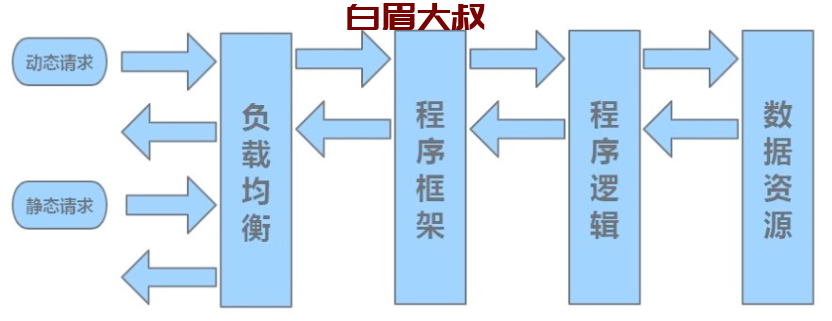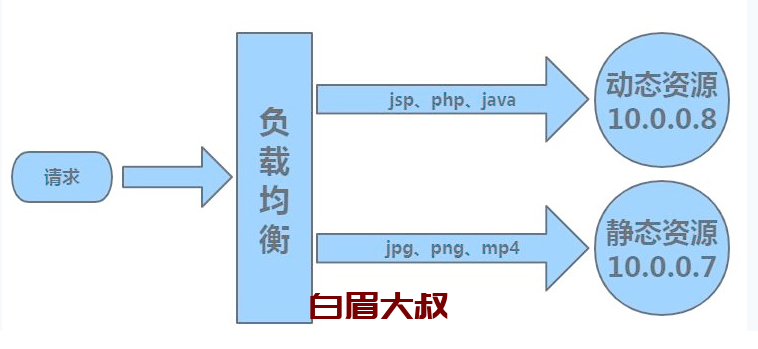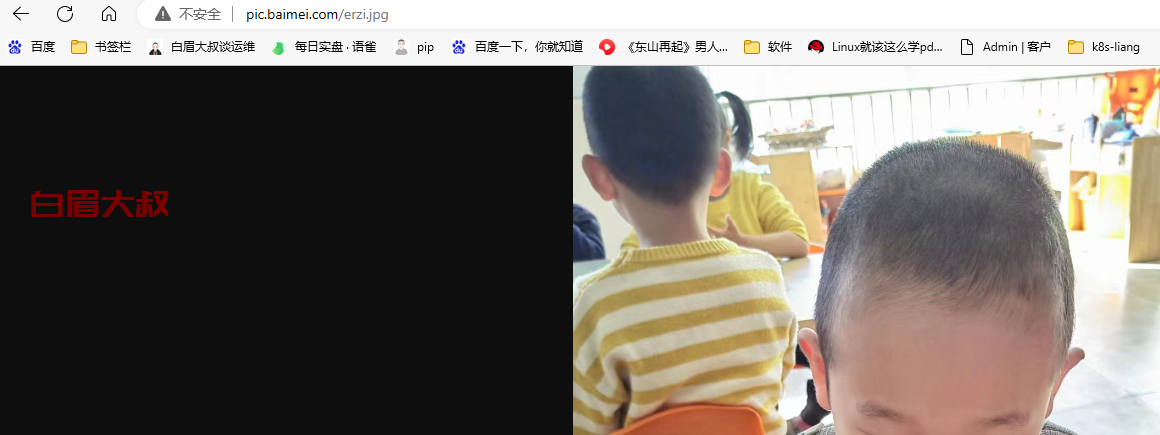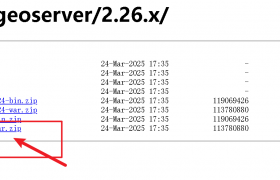Nginx动静分离
动静分离,通过中间件将动静分离和静态请求进行分离;
通过中间件将动态请求和静态请求分离,可以建上不必要的请求消耗,同事能减少请求的延时。
通过中间件将动态请求和静态请求分离,逻辑图如下:

动静分离只有好处:动静分离后,即使动态服务不可用,但静态资源不会受到影响。
单台服务器实现动静分离 参考:
nignx单台实现动静分离测试 (安装 tomcat 安装java )

| 系统 | 作用 | 服务 | 地址 |
|---|---|---|---|
| Centos7.5 | 负载均衡 | nginx proxy | 10.0.0.5 |
| Centos7.5 | 静态资源 | nginx static | 10.0.0.7 |
| Centos7.5 | 动态资源 | tomcat server | 10.0.0.8 |
web01配置静态资源:
|
打开浏览器访问:pic.baimei.com/erzi.jpg

web02配置动态资源
[root@web02 ~]# yum install -y tomcat
[root@web02 ~]# mkdir /usr/share/tomcat/webapps/ROOT
[root@web02 ~]# cat /usr/share/tomcat/webapps/ROOT/java_test.jsp
<%@ page language="java" import="java.util.*" pageEncoding="utf-8"%>
<HTML>
<HEAD>
<TITLE>baimeidashu JSP Page</TITLE>
</HEAD>
<BODY>
<%
Random rand = new Random();
out.println("<h1>baimeidash 随机数:<h1>");
out.println(rand.nextInt(99)+100);
%>
</BODY>
</HTML>
[root@web02 webapps]# systemctl start tomcat
打开浏览器,访问:http://10.0.0.8:8080/java_test.jsp
负载均衡上调度
[root@lb01 conf.d]# cat proxy_ds.conf
|
upstream static { upstream java { } location / { |
[root@lb01 conf.d]# nginx -t
nginx: the configuration file /etc/nginx/nginx.conf syntax is ok
nginx: configuration file /etc/nginx/nginx.conf test is successful
[root@lb01 conf.d]# nginx -s reload
2.5 配置本地hosts,通过负载访问动态与静态资源
动态资源
pic.baimei.com/java_test.jsp
静态资源 ↓
pic.baimei.com/erzi.jpg

负载均衡上整合动态和静态的html文件
#编辑配置文件
[root@lb01 ~]# cat /etc/nginx/conf.d/proxy_ds.conf
upstream static {
server 172.16.1.7:80;
}
upstream java {
server 172.16.1.8:8080;
}
server {
listen 80;
server_name pic.lzy.com;
location / {
root /code;
index index.html;
}
location ~* \.(jpg|png|gif)$ {
proxy_pass http://static;
proxy_set_header Host $http_host;
}
location ~ \.jsp {
proxy_pass http://java;
proxy_set_header Host $http_host;
}
}
[root@lb01 ~]# mkdir -p /code
#编辑整合后的index.html
[root@lb01 ~]# cat /code/index.html
<html lang="en"> <head> <meta charset="UTF-8" />
<title>测试ajax和跨域访问</title>
<script src="http://libs.baidu.com/jquery/2.1.4/jquery.min.js"></script> </head> <script type="text/javascript"> $(document).ready(function(){ $.ajax({ type: "GET", url: "http://pic.baimei.com/java_test.jsp", success: function(data){ $("#get_data").html(data) }, error: function() { alert("哎呦喂,失败了,回去检查你服务去~"); } }); }); </script> <body> <h1>测试动静分离</h1> <img src="http://pic.baimei.com/erzi.jpg"> <div id="get_data"></div> </body> </html>
浏览访问测试动静分离是否能成功
pic.baimei.com

可以尝试关掉静态或者动态的服务,测试是否互不影响
cat index.jsp Nginx资源分离场景实践
Nginx通过负载均衡实现手机与PC调度至不同的后端节点应用案例
根据Iphone、安卓、pc跳转不通的页面环境规划
| 系统版本 | 主机角色 | 外网IP | 内网IP | 提供端口 |
|---|---|---|---|---|
| CentOS7.5 | 负载均衡 | 10.0.0.5 | 172.16.1.5 | 80 |
| CentOS7.5 | 提供Android页面 | 172.16.1.7 | 9090 | |
| CentOS7.5 | 提供Iphone页面 | 172.16.1.7 | 9091 | |
| CentOS7.5 | 提供pc页面 | 172.16.1.7 | 9092 |
1.配置后端WEB节点的Nginx配置
[root@web01 conf.d]# vim sj.conf
server {
listen 9090;
location / {
root /code/android;
index index.html;
}
}
server {
listen 9091;
location / {
root /code/iphone;
index index.html;
}
}
server {
listen 9092;
location / {
root /code/pc;
index index.html;
}
}
2.为后端WEB节点配置对应的网站目录及代码
[root@web01 conf.d]# mkdir /code/{android,iphone,pc}
[root@web01 conf.d]# echo "我是安卓" > /code/android/index.html
[root@web01 conf.d]# echo "我是iphone" > /code/iphone/index.html
[root@web01 conf.d]# echo "我是computer" > /code/pc/index.html3.配置负载均衡服务,根据不同的浏览器调度到不同的资源地
欢迎来撩 : 汇总all



